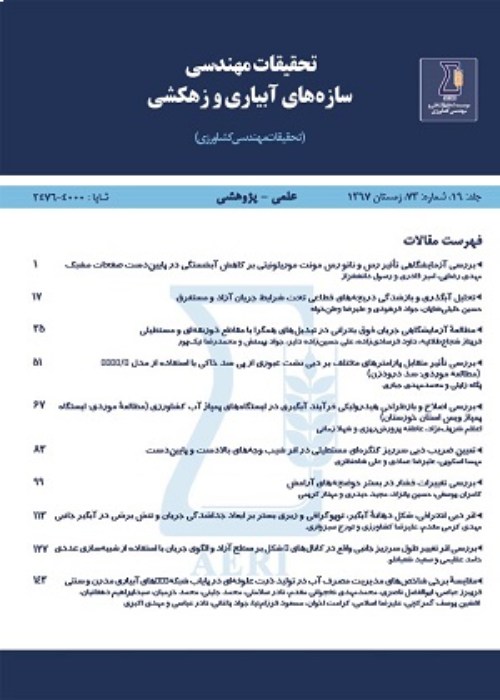Optimization Distance and Depth of laterals in Subsurface Drip Irrigation Systems (SDI) alfalfa
Alfalfa is irrigated by drip, strip, Furrow and rain irrigation methods. Surface irrigation methods are unjustifiable and not economical due to the low potential of irrigation efficiency in dry areas. Rain irrigation methods cannot be justified in hot and dry areas due to high evaporation and high water requirement of alfalfa. Alfalfa is a plant whose leaves are sensitive to burns caused by poor quality water as a result of water spraying in the rain irrigation method (Hengeller, 1995). Micro irrigation methods (surface and subsurface drip) are among the alternative methods of rain methods. The subsurface drip irrigation method has not been developed in Iran due to the existence of ambiguities and some dark and unclear points regarding its efficiency for crops (clogged outlets, salt accumulation, risk of blockage of pipes by roots). These concerns require that before any development of subsurface drip irrigation method for different crops, necessary researches should be done in this field. Therefore, conducting any research on the efficiency of this method for alfalfa, which is a valuable fodder plant but requires a lot of water, seems necessary. This research was conducted with the aim of investigating the effect of subsurface drip irrigation method on alfalfa yield, the amount of water consumed and determining the appropriate distances and depths for sub-pipes.
In order to investigate the effect of installation depth and distance of irrigation strips (laterals) in subsurface drip irrigation method on yield and water use efficiency in alfalfa cultivation, a study was conducted for two years on the farm of Damghan Agricultural Research Station. The design was implemented in the form of split strips based on randomized complete blocks with two factors and three replications. Factors included: 1- Distance of irrigation strips from each other in three levels (80, 100 and 120 cm) 2- Depth of installation of irrigation strips in two levels (30 and 45 cm below the soil surface). Depth of strips installation was considered as the main factor and distances as the sub-factor. The length of each experimental plot was 60 m and the width of the plots for the distances of 80, 100 and 120 cm were selected as 4, 5 and 6 m, respectively. Strips irrigation with a with a diameter of 20 mm with a discharge of 1.6 (lit/hr) and a distance of 60 cm for each dropper were selected. After preparing the ground and sowing the seeds, the subsurface irrigation pipes were placed (according to the treatments) with using the machine. Irrigation water was calculated by Penman-Monteith method and was given to the plant with an irrigation cycle of 4 days.
The results showed that the effect of pipe spacing on product yield (dry matter) and water use efficiency was significant, but the effect of pipe installation depth on yield and water use efficiency was not significant. The interaction effect of distance and depth of tapes irrigation on crop yield and water use efficiency was significant. There was no significant difference between crop yield in treatments with lateral distance of 80 and 100 cm. With increasing lateral distance from 80 to 120 cm, crop yield decreased sharply. Due to the yield of treatments and the cost of subsurface drip irrigation, the treatment of lateral distance of 100 and depth of 45 cm was suggested as the superior treatment.
The subsurface drip irrigation method for perennial crops is one of the efficient and appropriate methods. This method has a much higher efficiency than other irrigation methods due to the reduction of evaporation losses and the increase of irrigation efficiency especially in arid and semi-arid areas. The non-interference of irrigation in this method with the traffic of agricultural machines (especially during harvest) increases the ability and functionality of this method. But one of the problems of this method is the damage of rodents to the sub-pipes under the soil surface, which makes it difficult to determine the places of damage and repair them. Based on the results of this research, to prevent the damage of rodents, it is recommended to fight against these rodents and also to increase the installation depth of secondary pipes up to 50 cm. Clogging of droppers caused by poor filtration performance and penetration into and around the pipes are other problems of this method. To avoid these problems, it is recommended to inject acid and herbicide regularly into the irrigation system.
- حق عضویت دریافتی صرف حمایت از نشریات عضو و نگهداری، تکمیل و توسعه مگیران میشود.
- پرداخت حق اشتراک و دانلود مقالات اجازه بازنشر آن در سایر رسانههای چاپی و دیجیتال را به کاربر نمیدهد.



